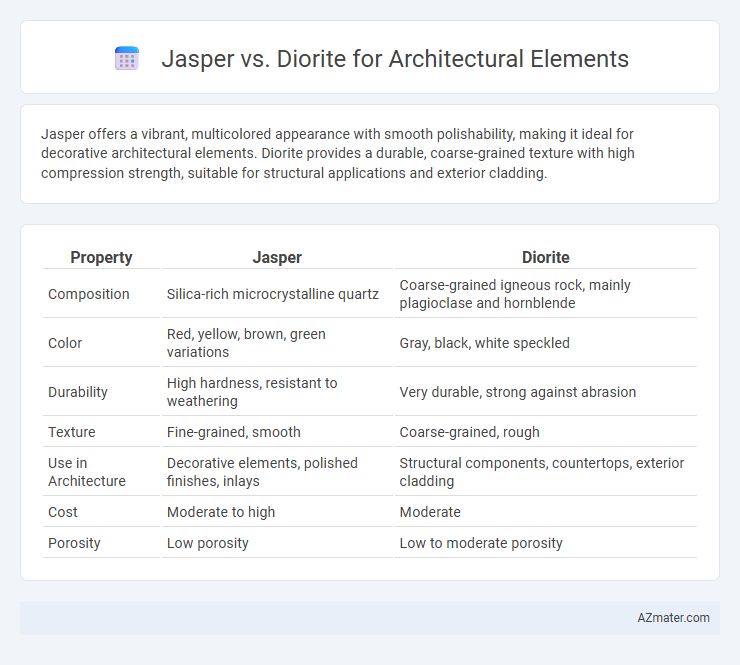Jasper offers a vibrant, multicolored appearance with smooth polishability, making it ideal for decorative architectural elements. Diorite provides a durable, coarse-grained texture with high compression strength, suitable for structural applications and exterior cladding.
Table of Comparison
| Property | Jasper | Diorite |
|---|---|---|
| Composition | Silica-rich microcrystalline quartz | Coarse-grained igneous rock, mainly plagioclase and hornblende |
| Color | Red, yellow, brown, green variations | Gray, black, white speckled |
| Durability | High hardness, resistant to weathering | Very durable, strong against abrasion |
| Texture | Fine-grained, smooth | Coarse-grained, rough |
| Use in Architecture | Decorative elements, polished finishes, inlays | Structural components, countertops, exterior cladding |
| Cost | Moderate to high | Moderate |
| Porosity | Low porosity | Low to moderate porosity |
Overview: Jasper vs Diorite as Architectural Materials
Jasper and Diorite are both valued architectural materials, with Jasper known for its rich, vibrant colors and unique patterns that enhance aesthetic appeal in decorative elements. Diorite offers superior durability and strength due to its coarse-grained igneous composition, making it ideal for structural components and exterior cladding. Choosing between Jasper and Diorite depends on the balance between visual impact and functional performance required in architectural applications.
Geological Origins and Composition
Jasper, a microcrystalline variety of quartz, forms from silica-rich sediment or volcanic ash through intense pressure and heat, resulting in a dense, opaque stone with vibrant colors caused by iron inclusions. Diorite, an intrusive igneous rock, crystallizes slowly beneath the Earth's surface from magma rich in plagioclase feldspar and hornblende, creating a coarse-grained texture with a distinctive salt-and-pepper appearance. The contrasting geological origins and mineral compositions influence their structural properties and aesthetic appeal in architectural elements, with jasper favored for its vivid hues and diorite valued for its durability and speckled patterns.
Physical Properties Comparison
Jasper exhibits a hardness rating of 6.5 to 7 on the Mohs scale, characterized by a dense, fine-grained texture and vibrant color variations, making it suitable for intricate architectural details requiring durability and aesthetic appeal. Diorite possesses a higher hardness of approximately 6 to 7, with a coarse-grained, granular texture and primarily muted color tones, offering superior strength and resistance to weathering in structural elements. Both stones demonstrate excellent compressive strength, but Diorite's mineral composition grants it enhanced toughness for load-bearing applications, while Jasper's polishability favors decorative finishes.
Aesthetic Appeal and Color Variations
Jasper offers a rich, multi-hued palette with deep reds, greens, and browns that create striking, warm architectural elements, making it ideal for designs seeking natural vibrancy and earthy elegance. Diorite presents a more subdued, polished aesthetic with its speckled black and white matrix, delivering a sleek, modern look that complements minimalist and contemporary styles. The choice between Jasper and Diorite hinges on whether the design prioritizes bold color variation and warmth or a monochromatic, refined stone texture.
Durability and Weather Resistance
Jasper offers exceptional durability and strong resistance to weathering due to its dense, fine-grained structure, making it ideal for architectural elements exposed to harsh conditions. Diorite also provides significant strength and weather resistance, characterized by its coarse-grained texture and composition of feldspar and quartz, but it may be more prone to surface erosion compared to jasper. Both materials are suitable for exterior use, yet jasper's superior hardness and lower porosity typically result in better long-term durability and resistance to moisture infiltration.
Workability and Finishing Techniques
Jasper exhibits excellent workability due to its fine-grained structure, allowing precise carving and intricate detailing for architectural elements, while Diorite's coarse-grained texture demands more robust tools and techniques, often resulting in a rougher finish. Finishing Jasper yields a high-polish, vibrant surface that enhances its natural color variations, making it ideal for decorative, smooth surfaces. Diorite, known for its durability, responds well to honing and leathering techniques, providing a matte to semi-polished finish suitable for robust, textured architectural features.
Cost and Availability
Jasper exhibits higher cost due to its rarity and complex quarrying process, making it less accessible for large-scale architectural elements compared to Diorite. Diorite is widely available and more affordable, often chosen for budget-conscious projects requiring durable natural stone. The price difference influences material selection, with Diorite preferred for cost-efficiency and Jasper favored for luxury designs.
Applications in Modern Architecture
Jasper's rich, vibrant colors and natural patterns make it a popular choice for decorative wall panels and intricate flooring designs in modern architecture, enhancing spaces with a luxurious, earthy aesthetic. Diorite's durability and subtle, speckled appearance are favored for structural elements like load-bearing columns and facades, providing both strength and a refined, contemporary look. Both stones contribute to sustainable building practices by offering longevity and requiring minimal maintenance in architectural applications.
Sustainability and Environmental Impact
Jasper, a dense and durable natural stone, offers excellent longevity and low maintenance, reducing the need for frequent replacements and minimizing environmental impact over time. Diorite, known for its hardness and resistance to weathering, also provides sustainable benefits through its natural abundance and minimal processing requirements, lowering carbon emissions during extraction and fabrication. Both materials contribute to eco-friendly architectural designs by promoting durability and reducing waste, yet choosing locally sourced options can further enhance their sustainability credentials.
Choosing Between Jasper and Diorite for Architectural Projects
Jasper offers vibrant colors and intricate patterns that bring warmth and artistic expression to architectural elements, making it ideal for decorative features and accent walls. Diorite, known for its durability and coarse-grained texture, provides a timeless, elegant appearance suited for structural components and high-traffic surfaces in commercial and residential projects. Selecting between jasper and diorite depends on prioritizing aesthetic appeal versus strength and wear resistance in architectural design.

Infographic: Jasper vs Diorite for Architectural Element
 azmater.com
azmater.com